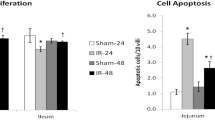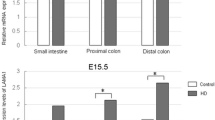Abstract
Purpose
Semaphorin 3A (Sema3A) is a protein secreted during development of the nervous system that plays an important role in neuronal pathophysiology. However, there is no known correlation between Sema3A and intestinal ischemia/reperfusion (I/R) injury. We assessed Sema3A expression and distribution in relation to enteric nervous system (ENS) damage seen after intestinal I/R injury in Sox10-Venus mice.
Methods
Intestinal I/R injury was induced by vascular occlusion for 3 h. Ileal specimens were harvested 0, 3, 12, 24, 48, and 96 h after reperfusion. Stereoscopic microscopy and fluorescence microscopy were used to assess sox10-Venus+ cells and PGP9.5+ cells.
Results
By 3 h after reperfusion, Sema3A expression had increased to a maximum and Sox10-Venus+ cells had faded to a minimum in harvested ileal segments. Both differences were statistically significant. By 96 h after reperfusion, both Sema3A and Sox10-Venus+ cell fluorescence had reverted to original levels. Hematoxylin and eosin staining identified histologic damage mimicking Sema3A expression, while PGP9.5+ cell response was minimal.
Conclusion
We are the first to demonstrate a correlation between Sema3A expression and ENS damage following intestinal I/R in Sox10-Venus mice.





Similar content being viewed by others
References
Roth L, Koncina E, Satkauskas S et al (2009) The many faces of semaphorins: from development to pathology. Cell Mol Life Sci 66:649–666
Ranganathan P, Jayakumar C, Mohamed R et al (2014) Semaphorin 3A inactivation suppresses ischemia-reperfusion-induced inflammation and acute kidney injury. Am J Physiol Renal Physiol 307:F183–F194
Jayakumar C, Ranganathan P, Devarajan P et al (2013) Semaphorin 3A is a new early diagnostic biomarker of experimental and pediatric acute kidney injury. PLoS One 8:e58446
Lindeström LM, Ekblad E (2004) Structural and neuronal changes in rat ileum after ischemia with reperfusion. Dig Dis Sci 49:1212–1222
Thacker M, Rivera LR, Cho HJ et al (2011) The relationship between glial distortion and neuronal changes following intestinal ischemia and reperfusion. Neurogastroenterol Motil 23:e500–e509
Shibata S, Yasuda A, Renault-Mihara F et al (2010) Sox10-Venus mice: a new tool for real-time labeling of neural crest lineage cells and oligodendrocytes. Mol Brain 3:31
Acknowledgements
This work was supported by JSPS KAKENHI Grant Number 26462715.
Author information
Authors and Affiliations
Corresponding author
Rights and permissions
About this article
Cite this article
Takeda, M., Miyahara, K., Okawada, M. et al. Semaphorin 3A expression following intestinal ischemia/reperfusion injury in Sox10-Venus mice. Pediatr Surg Int 33, 383–388 (2017). https://doi.org/10.1007/s00383-016-4039-2
Accepted:
Published:
Issue Date:
DOI: https://doi.org/10.1007/s00383-016-4039-2




